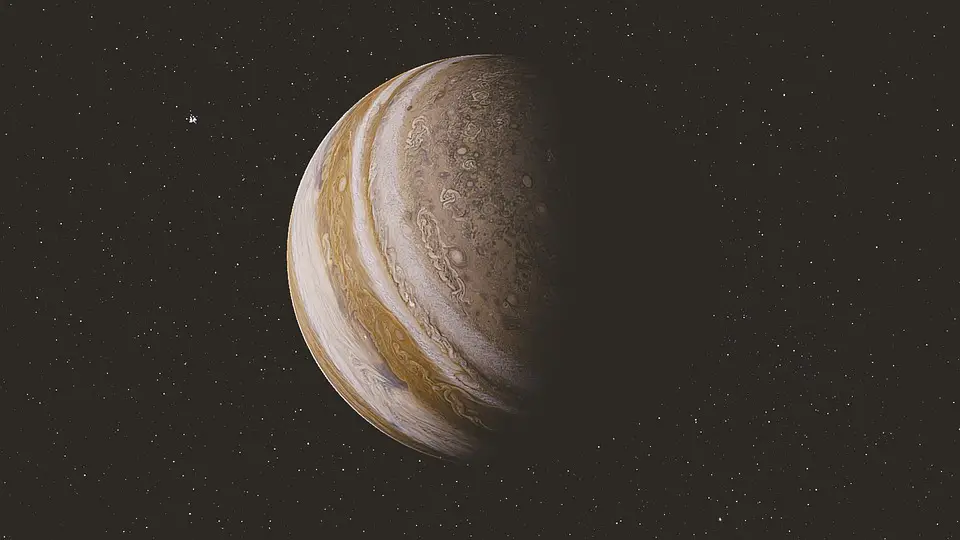Until it was recently overtaken by fellow gas giant and Jovian companion Saturn, Jupiter held the distinction of having the most number of moons in our solar system—the solar system’s largest planet’s moon menagerie numbered an impressive 79 known moons at the last count.

Here’s a quick introduction to Jupiter’s moons.
Ready? Let’s get started.
Jupiter’s Moons: A General Overview
Jupiter’s many moons follow elliptical/circular orbits with varying orbital periods—some merely take seven hours, while some take three years! While some orbit in the direction of the planet’s rotation, some errant ones, sitting far away from the planet, spin in the opposite direction.
Though the planet has 79 moons, the ones that primarily interested astronomers were its four largest moons, collectively known as the Galilean moons or satellites. These are named after the polymath Galileo, who discovered them in the first decade of the 17th century.

Most of the other moons were discovered three centuries later, as late as the 1970s, thanks to the Space Race and the explorations that automated space shuttles afforded.
Why Do Jupiter’s Moons Vary In Number?
One of the most interesting aspects of Jupiter’s moons is that the number of moons keeps varying.
This is because Jupiter’s massive size means that its gravitational pull is just as massive, which further means that if they’re close enough, bodies hurtling through space can get trapped in Jupiter’s system of moons when they pass by it (the alternative being getting destroyed).
Many of the moons that orbit against Jupiter’s spins are believed to exhibit such unusual orbital behavior because they were once asteroids that got trapped in the planet’s gravitational field.
Jupiter’s large size affords it the ability to support these many moons, unlike the Earth, which can only support one. Additionally, most moons are fairly small, roughly 6 miles across, so there’s not too much work being done by the planet to support these!
The Galilean Moons
Here’s a deeper look at Jupiter’s four most popular natural satellites.
Ganymede
Ganymede is not only Jupiter’s largest moon but also the solar system’s largest moon. This moon sits in the third position from Jupiter, and though it’s as big as Mercury, it only weighs half as much as the planet.
With a core of iron and a crust primarily composed of thick ice, Ganymede’s surface is a mix of craters and grooved terrain. The unique feature of this low-density moon is its personal magnetic field.
Io
This volcanic moon is the closest to Jupiter and also Galileo’s first discovery.
Io is generously peppered with volcanoes (its distinguishing characteristic) which sit in contrast to its snowfields of sulfur dioxide—a moon of ice and fire.
Owing to its outer layer of brown silicate and a core of iron, Io has a physical appearance of white, red, yellow, orange, red, and black.

Its proximity to Jupiter causes the latter’s gravitational pull to cause waves on the former’s surface, easily reaching a towering height of 300 feet.
Europa
Europa is about as large as our own moon but is still the smallest of the Galilean giants. This planet is the second nearest to Jupiter and due to its highly reflective surface, is one of the solar system’s brightest moons.
This moon is quite young, only around 180 million years old at most. The possibility of life on this moon is being studied with much fervor, as scientists believe that the moon’s icy exterior could be hiding a large, life-supporting ocean underneath.
Callisto
The last of the Galilean moons, Callisto orbits farther away from the planet than the other three. Like Ganymede, Callisto is close in size to Mercury but is nowhere near as dense.

This moon has captured scientists’ fascination with its unchanging surface and landscape—evidence shows that both have remained unaltered since the moon came into being.
Conclusion & Summary
Jupiter’s beautiful moons are still being explored, including the earliest discovered ones. Who knows—in the next few centuries, mankind may have even found a way to settle down on Europa!
For now, in the right conditions and with the right telescope or binoculars, you can enjoy glimpses of the Galilean moons, cutting across Jupiter with their steady light.
